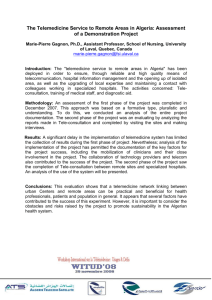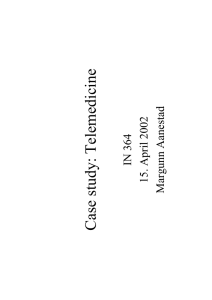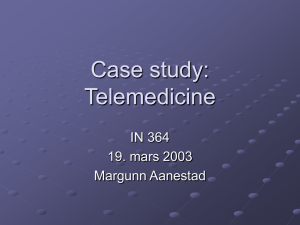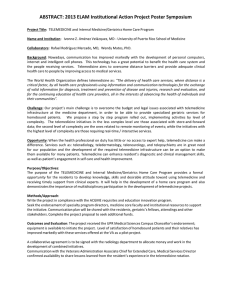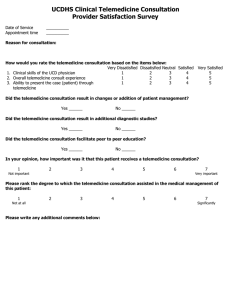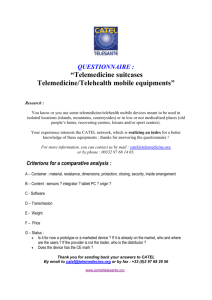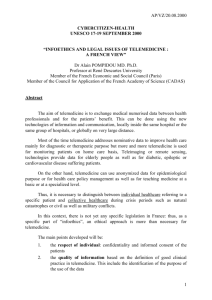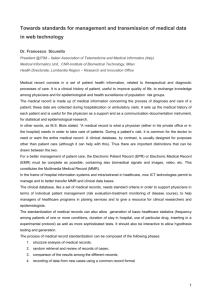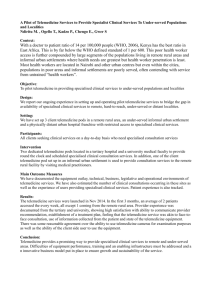Usual Care vs. Telemedicine
advertisement
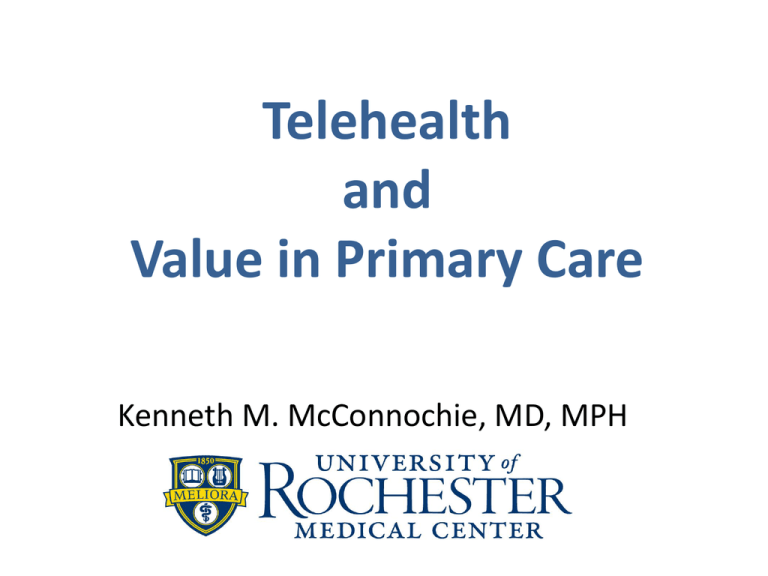
Telehealth and Value in Primary Care Kenneth M. McConnochie, MD, MPH Value of Telemedicine-Enhanced Care Wakening from naptime, temp 104. Age 6 mo., dropped off at childcare, 7:30 this morning. Diagnosis: acute otitis media Tomorrow Outcomes that Matter: Family Perspective Benefits Usual Care Child seen 4 hr later First dose of medication 6 hr later Benefits Patient to Provider Telemedicine Child seen now First pain medication now First antibiotic 1-2 hr later Cost to the Family and Community Usual Care Cost • Office , Urgent Care or ED exam room space • Personnel costs: nurses and med-techs • Parent misses ½ day of work • Transportation costs (?ambulance) • Parking cost • Payment for ED visit: $650 • Medication costs • Provider cost Patient to Provider Telemedicine Cost • Little or no cost for patient exam room space • Patient-end equipment and connectivity • No incremental cost for provider space or equipment • Personnel costs: med-tech (telemed assistant) and scheduler • No transportation or parking cost • Parent misses no work • Payment for telemed visit: $75 • Medication costs (equal) • Provider cost (equal or less) Relative Value: Family and Community Perspective Telemedicine >> Usual Care Benefits Benefits Cost Cost Child site Secure internet connection Provider site Video conference window view at clinician site Video conference window view at child site Days Absent Due to Illness* Effectiveness: Absence from Child Care Due to Illness Before Jan July Dec * Absence due to illness in mean days per week per 100 registered child-days. Effectiveness and Efficiency: Summary • Reduction in absence from child care due to illness: 63% • Visits completed > 14,000 • In child care, schools, center for special needs children, neighborhood/after-hours sites > 70 sites • Completion rate: 97% (3% referred to higher level of care) • Would otherwise have gone to ED, Urgent Care or office: 94% • Allowed parent to stay at work/school: 93% (estimated time saved = 4.5hr/visit) Effectiveness and Efficiency: Summary • Continuity with Primary Care Medical Home: 83% • Provider participation: – primary care practices = 10 – providers > 70 • Local payer reimbursement: – City children covered ~ 90% (Medicaid managed care, Commercial) – Not yet paying: FFS Medicaid ~6% – Uninsured ~ 4% Effectiveness and Efficiency: Potential • Observed reduction in ED visits: Fewer among children in regular city elementary schools and childcare - at least 22% Fewer among special needs children attending a child development center - almost 50% • Pediatric primary care office visits appropriate for telemedicine = 85% • Pediatric emergency department visits appropriate for telemedicine = 40% Newer Primary Care Models Pediatric Acute-Illness Care ♦ Neighborhood/after-hours access - avoid ED Pediatric Chronic Problem Care ♦ Asthma management – avoid school absence, ED, hospital ♦ ADHD management – avoid grade retention, school dropout Pediatric Dentistry ♦ Dental screening – avoid extensive dental work, tooth loss Geriatric Acute-Illness Care ♦ Senior Living Communities - avoid ED, hospital ♦ Home-based monitoring – detection deterioration early, avoid ED, hospital Primary Care Applications • Unlimited • Health care is fundamentally a process of information acquisition, interpretation and exchange • At some point in the care process for any problem, it is advantageous to patients to engage at a distance. Barriers • • • • • • • Deeply entrenched care process Human response to uncertainty Provider scarcity Fee-for-service financing Productivity measured as units of service Lack of relevant regulations Lack of established “best practices” Value and the Continuums of Information Requirements and Capacity Level 9: Medical Center Level 3: Info-Abundant Telemedicine Level 2: Telemedicine light: Videoconference Level 1: Telephone only Capacity to acquire and exchange information: Scope and quality Abundant Capacity Avoidable cost Avoidable risk Information required for diagnosis and management decisions: Scope and quality Abundant Requirements Facilitators Organize into Integrated Practice Units (IPUs) Measure and focus on outcomes that are most meaningful to patients Cost-based accounting Bundled payment for care cycles Enabling information technologies (the continuum) Care guidelines (“best practices”) and regulations enabling all the above 20,000 Foot Perspective • Disruptive innovation – Clayton Christenson • Creative destruction – Joseph Schumpeter • “All costs are variable in the long run”
